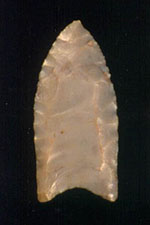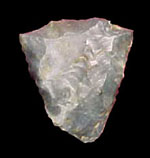Over 55,000 artifacts were recovered from the Nobles Pond site. Although the majority of the artifacts are waste flakes from the manufacture and reworking of stone tools, the collection also includes over 7,000 stone tools and tool fragments. The array of tools includes 95 fluted points and preforms in various stages of manufacture, hundreds of end scrapers and gravers, and various other tools and tool fragments.
Because the soil at Nobles Pond is acidic, it destroys most organic materials within a few hundred years. Therefore, no Paleoindian wood, bone, hide, or fiber was recovered from the site. Only stone tools survived from the Paleoindian period. This rapid loss of organic artifacts is true for most Ohio Paleoindian sites, with the exception of a very few sites such as Sheriden Cave in northwestern Ohio.
Tool Types
Although fluted points are the hallmark of most Paleoindian sites, more than 25 other types of stone tools have been identified in the Nobles Pond collection. End scrapers are by far the most common formal Paleoindian tool at Nobles Pond. They are about 20 times more plentiful than the fluted points and preforms.
The collection also includes gravers, side scrapers, notches, burins and narrow-nose scrapers, to name just a few tool types.
Raw Materials
About half of the Paleoindian tools at Nobles Pond are made from Upper Mercer chert, which comes from the Coshocton, Ohio area. A bit less than half of the tools are made from Flint Ridge chert, which comes from the Newark, Ohio area. A small percentage of tools are made from Wyandotte chert and Attica chert, both from Indiana.
Testing and Analysis
Nobles Pond tools have been examined and tested using a variety of methods.
Protein residues remaining on stone tools can indicate which animals the tools were used on. We tested more than 100 tools for protein residues. The greatest number of positive test results was for cervids (deer, elk, moose, caribou and so on) and for rabbits/hares.
Use wear analysis can reveal what kind of materials (wood, leather and so on) the tools were used on, based on scratches or polishing seen on the tools. Most of the end scrapers that were examined had been used to scrape animal hides.
Putting pieces back together can provide insights about how tools are manufactured, used, broken, and repaired. Our refitting program attempts to put thousands of tool fragments and waste flakes together. We have found a number of pieces that fit together, but this program is still going on, and the results have not yet been fully analyzed.
Curation of Artifacts
Currently, most of the artifacts recovered from the Nobles Pond site reside in the archaeology laboratory at Kent State University, Stark County campus, for analysis and documentation. Once analysis has been completed, the collection will be curated by a local museum.



